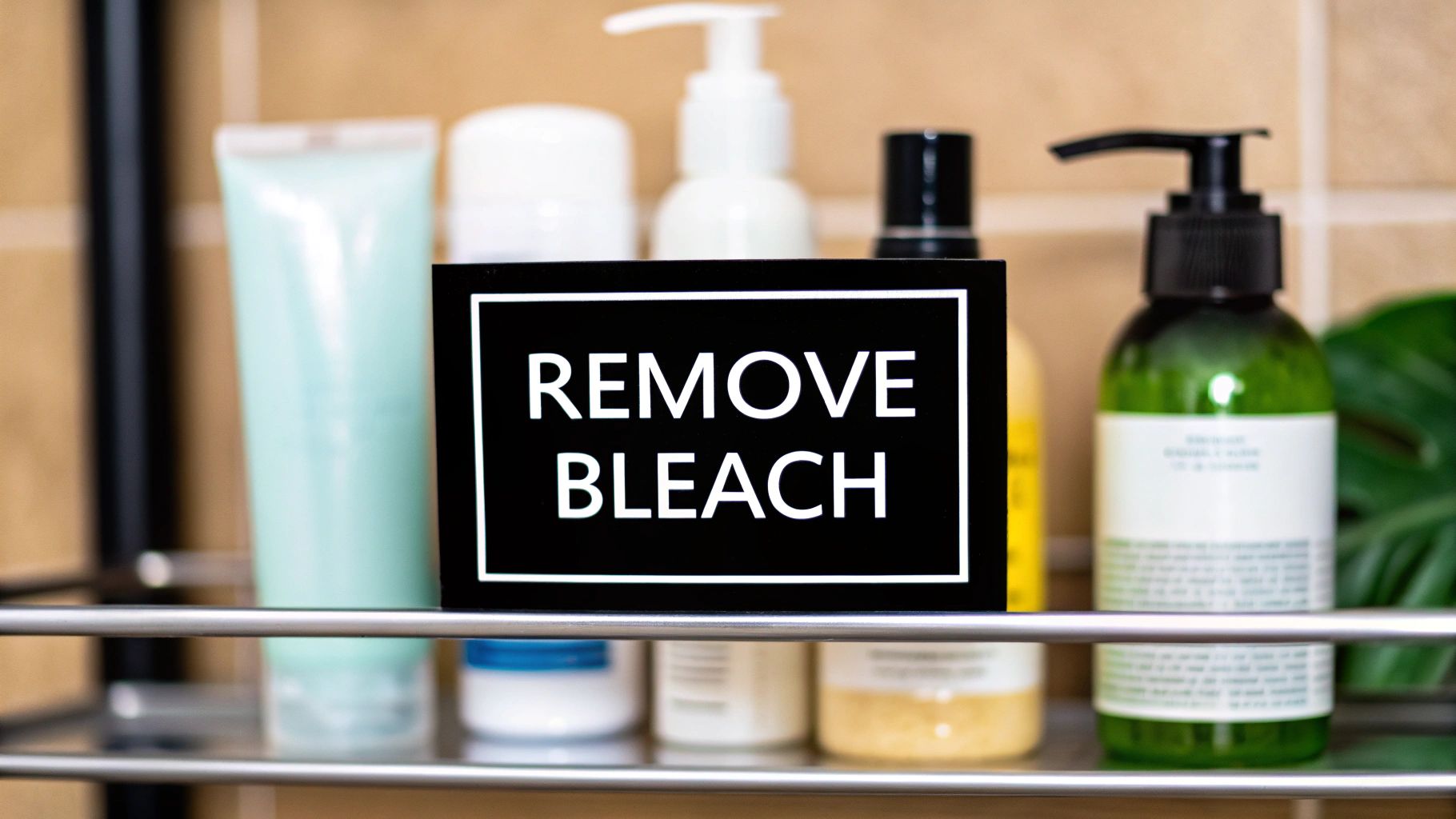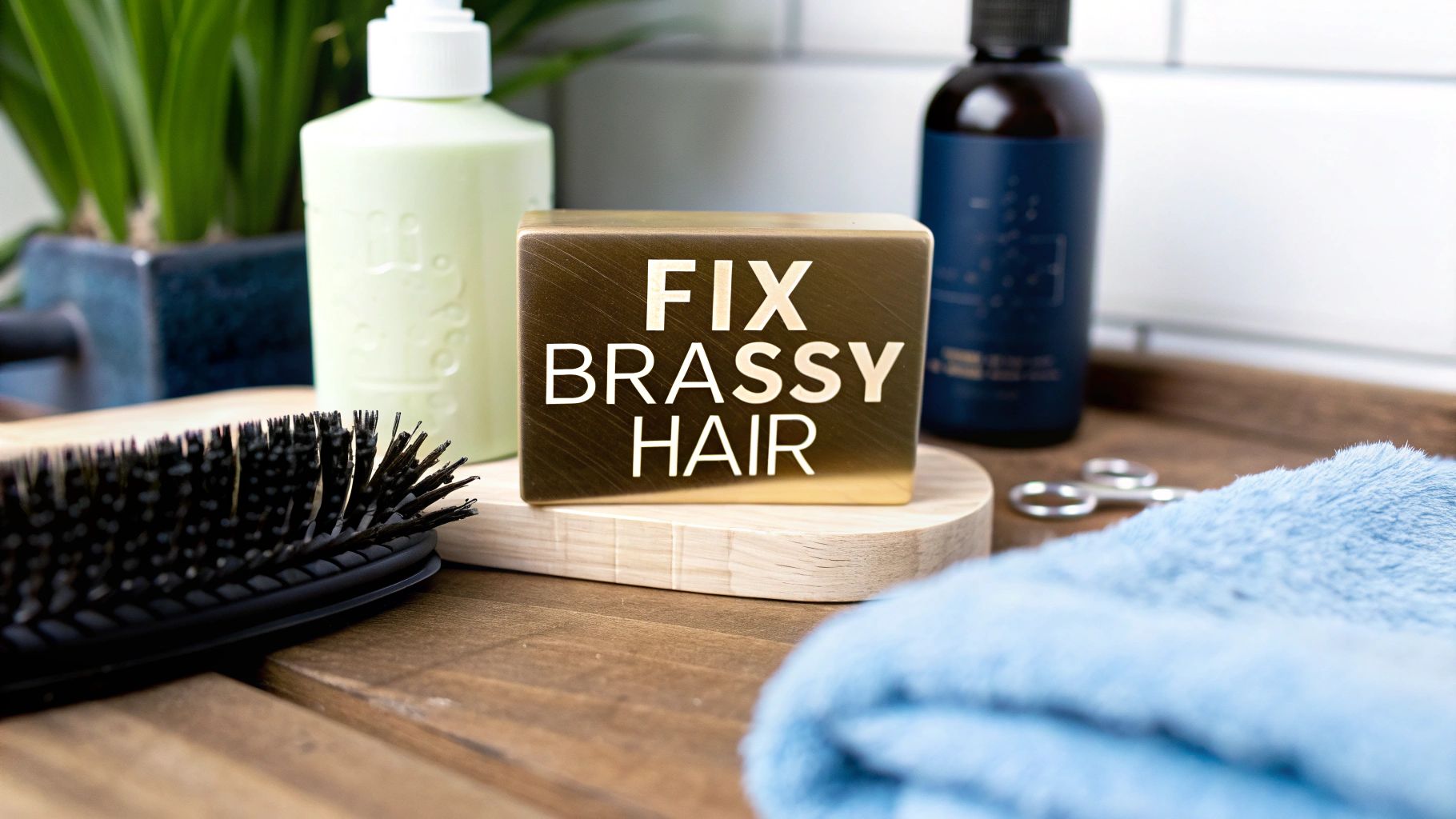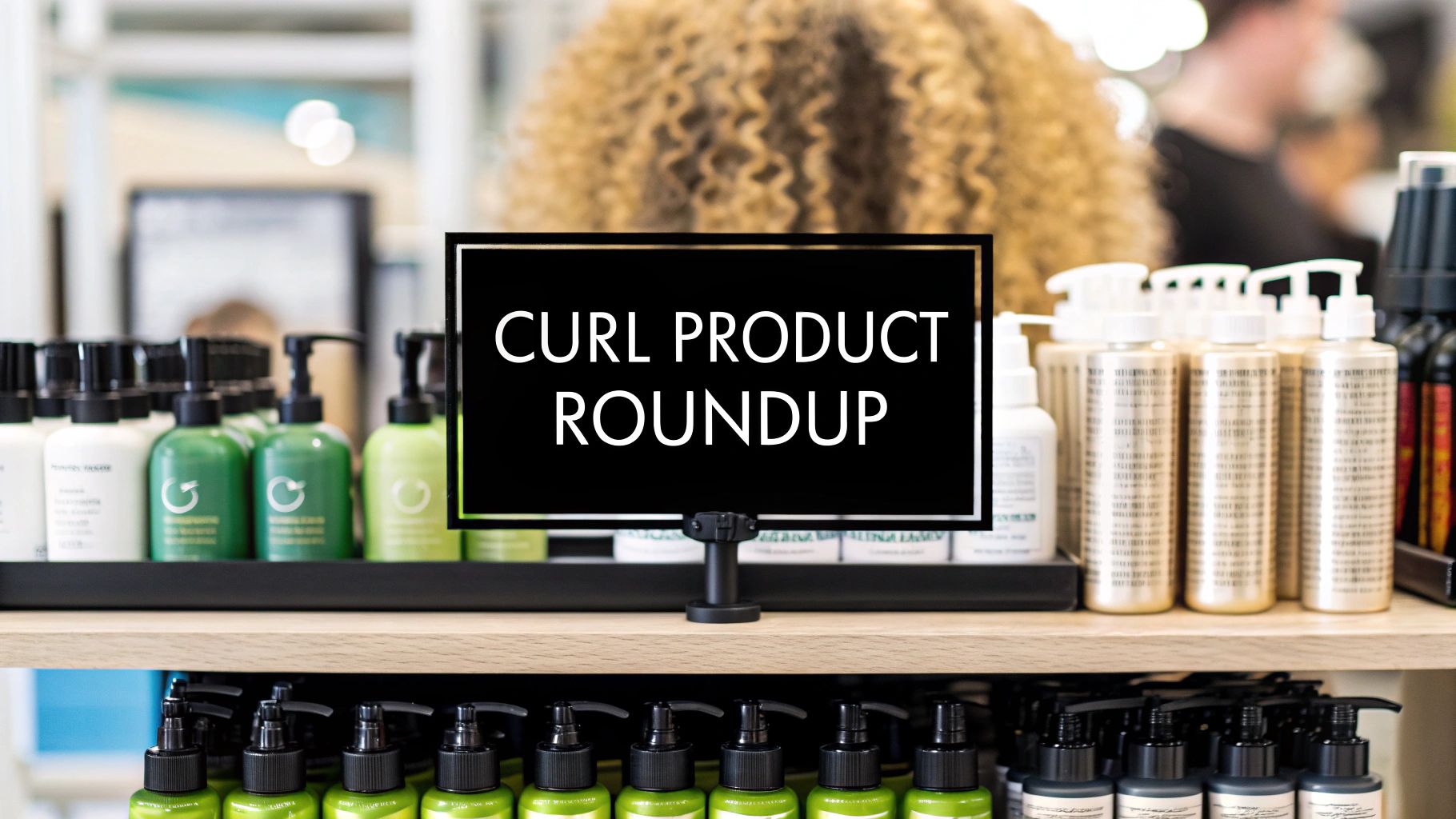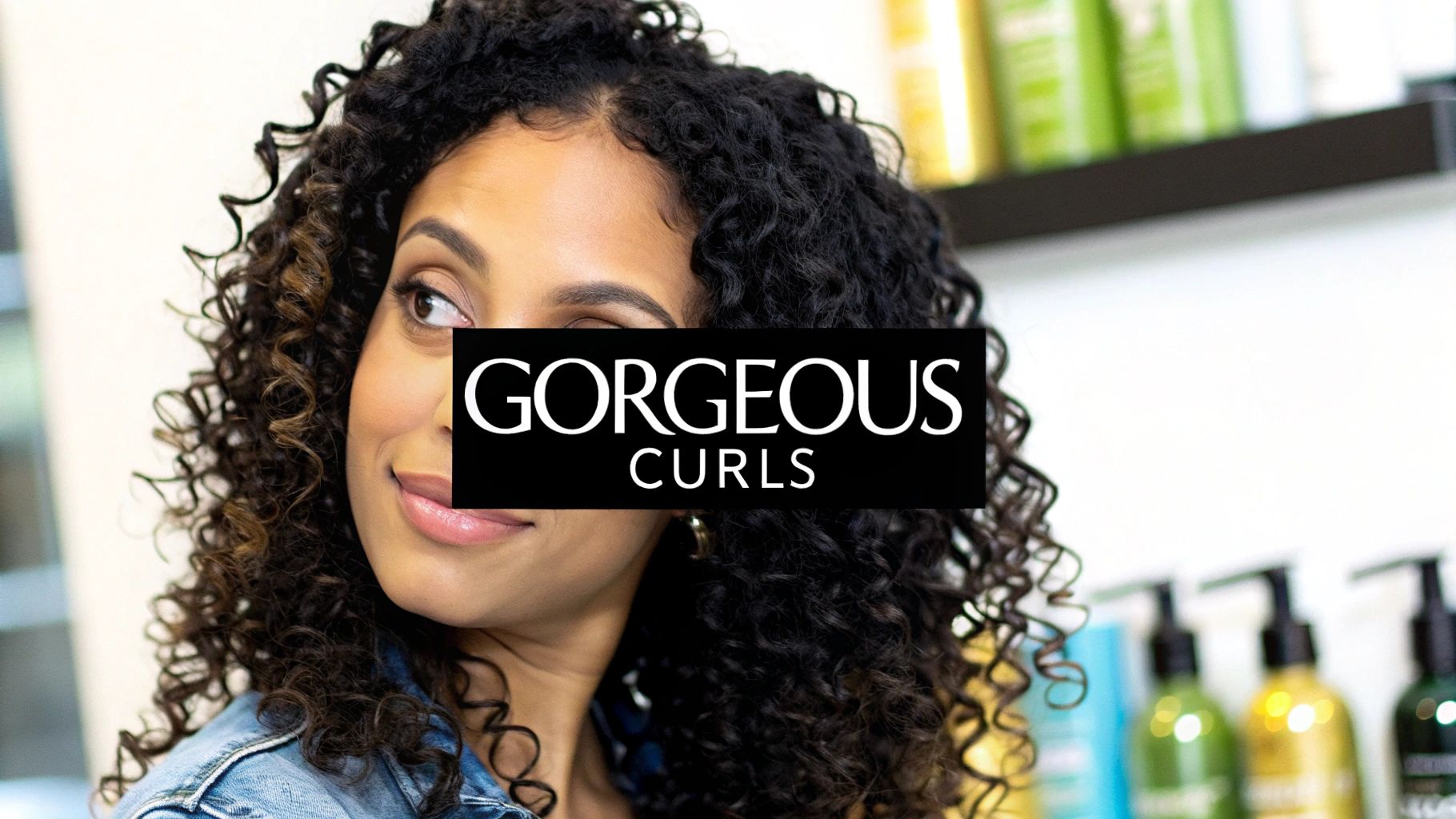Let’s get one thing straight: you can't just "wash out" bleach like you would a shampoo. It's a chemical process, not a product sitting on the surface. The real goal here is to stop the chemical reaction in its tracks and kickstart the repair process. This means bringing in some heavy-hitting products designed to halt further damage and begin rebuilding your hair’s internal structure.
Thank you for reading this post, don't forget to subscribe!Why You Need to Act Fast After Bleaching

To fix the problem, you first have to understand what bleach actually does to your hair. It’s an aggressive process. The lightener forces open the hair’s protective outer layer (the cuticle) to get inside and dissolve the melanin pigments that create your natural color.
This chemical intrusion is, by its very nature, destructive. It breaks down the fatty acids and essential protein bonds (keratin) that give your hair its strength and integrity. That’s exactly why freshly bleached hair feels so different—it’s been structurally compromised and is incredibly vulnerable.
Recognizing Over-Processed Hair
When a bleach job goes wrong, your hair sends out immediate SOS signals. These are the red flags telling you that your hair is in crisis mode and needs help, fast.
- Gummy or Mushy Texture: When your hair is wet, does it feel weirdly soft, slimy, or almost like mush? That’s a major sign it has lost its internal structure.
- Extreme Brittleness: Once it's dry, it might feel like straw and snap off with the slightest touch or pull.
- High Porosity: Over-processed hair acts like a sponge. It soaks up water and products instantly but can't hold onto any of it, leaving it perpetually dry.
Timing is everything. Your first move should be to neutralize the bleach's high-alkaline pH and start flooding your hair with the proteins and moisture it just lost. As you start the recovery process, it’s a good idea to be mindful of what you're putting on your already-fragile hair; for instance, some people choose to avoid certain toxic chemicals in shampoos.
Your immediate response sets the stage for recovery. The longer the harsh chemicals linger and the structural damage is left unaddressed, the harder it will be to restore your hair's health.
The good news? Acting quickly can make a world of difference. Studies have shown that up to 80-90% of bleach damage can be mitigated if you treat it within the first 24-48 hours. This involves using pH-balancing shampoos and protein-rich conditioners to reinforce the weakened hair fibers. This isn't just about making your hair look better temporarily; it's a critical first-aid intervention to save your strands from the brink.
Your First 48 Hours: A Bleach Damage Action Plan
When you realize your hair has been pushed too far by bleach, what you do in the next 48 hours can make a world of difference. Your hair is incredibly fragile at this point, so your normal routine is out the window. Think of this as hair triage—the goal is to stabilize the situation and prevent a bad situation from getting worse.
The very first mission? Stop the chemical process in its tracks. You might have rinsed, but residual bleach can linger, continuing to eat away at your hair's structure because of its high alkaline level. This is where a specific type of shampoo becomes non-negotiable.
First, Halt the Damage With the Right Cleanse
Put your everyday shampoo aside for a moment. You need something more targeted, like a clarifying or chelating shampoo. These are specifically formulated to strip away chemical residues and stubborn mineral buildup.
Look for products with ingredients like EDTA (ethylenediaminetetraacetic acid). This ingredient is a powerhouse at grabbing onto those lingering alkaline agents and washing them away for good. This single step is crucial for rebalancing your hair's pH, essentially hitting the "off" switch on the damage.
This infographic breaks down a simple way to create your own pH-balancing rinse at home.

As the visual guide shows, it’s all about getting the ratios right to create a rinse that's gentle enough for fragile hair but effective enough to neutralize the pH.
Choosing the right approach to neutralize bleach is key. Here's a quick comparison of the methods you'll encounter.
Bleach Removal Method Comparison
| Method | Primary Purpose | Best For | Key Ingredients to Look For |
|---|---|---|---|
| Clarifying Shampoo | Deeply cleaning and removing product buildup | Hair that feels heavy or greasy from products | Sulfates (for deep cleansing), Apple Cider Vinegar |
| Chelating Shampoo | Removing mineral deposits and chemical residues | Hair exposed to hard water or post-chemical processing | EDTA, Phytic Acid, Sodium Gluconate |
| DIY pH-Balancing Rinse | Neutralizing alkaline residues gently | Immediate post-bleach treatment; sensitive scalps | Apple Cider Vinegar, Distilled Water |
| Bond-Building Cleanser | Starting the repair process during the wash | Severely damaged, "gummy" or elastic-feeling hair | Maleic Acid, Bis-Aminopropyl Diglycol Dimaleate |
Each of these methods has its place, but for immediate post-bleach care, a chelating shampoo is often the most effective professional-grade choice to ensure all damaging residues are gone.
Next, Begin Intensive Repair Immediately
Once you're confident the chemical process has stopped, it's all about repair. Your hair is like a sponge full of holes—porous and stripped of the proteins and lipids that give it life. Now it's time to start filling those holes back in.
Grab a high-quality bond-building mask or a really rich deep conditioner. These aren't your average conditioners; they're packed with concentrated ingredients like amino acids, ceramides, and keratin that work to rebuild your hair's internal structure from the inside out.
Pro Tip: I always tell my clients to apply treatments to damp, towel-dried hair and leave them on for at least 20-30 minutes. To really boost its power, pop on a shower cap. The trapped heat from your scalp helps the hair cuticle open up, allowing the treatment to penetrate much more deeply.
Your immediate goal is to flood your hair with moisture and strength. Thanks to modern cosmetic science, these products are incredibly effective. Some protein rebuilders can reduce breakage by around 30%, and chelating shampoos have been shown to be over 25% more effective at removing bleach residue than standard formulas.
Finally, and this is a big one: put away the heat tools. The flat iron, the curling wand, the blow dryer—they are not your friends right now. Adding heat to already compromised hair is a recipe for disaster. Learning how to style hair without heat is an essential skill while your fragile strands are in recovery.
Neutralizing Unwanted Brassy and Yellow Tones

Okay, so you've navigated the initial crisis and your hair is on the road to recovery. Now, let's talk about the color. It’s the rare head of hair that lifts to a perfect, pristine blonde in one go. More often than not, bleach just exposes the hair's natural underlying pigments, leaving you with shades of yellow or even a stubborn orange.
This is where a little bit of color theory saves the day. To cancel out an unwanted color, you need to apply its opposite from the color wheel. It's a simple concept, but it's the science behind every toning product on the shelf.
Choosing Your Toning Weapon
For regular upkeep, toning shampoos are an absolute must-have. They gently deposit a bit of pigment with every wash to keep brassiness at bay, but you have to choose the right color for the job.
- Purple Shampoo: This is your secret weapon against yellow tones. If your hair is giving off a pale, banana-peel vibe, a good purple shampoo will neutralize it.
- Blue Shampoo: This one is specifically for tackling orange or brassy tones. If you're seeing more of a coppery glint, reach for the blue stuff.
Mixing these up is a common mistake. Using a purple shampoo on orange-toned hair, for instance, won't do much of anything. You're just washing your hair with a pretty color that won't fix the problem.
And if you're battling brassiness, you're in good company. Market data shows that approximately 45% of people who bleach their hair struggle with unwanted tones, which is why the corrective product market is huge. In fact, the global market for these toning and repair products hit nearly $7.3 billion in 2022. You can dig into more stats about hair product market growth at Wise Guy Reports.
A toner or gloss is essentially a gentle, semi-permanent color designed only to deposit tone, not lift your hair further. It corrects unwanted shades while adding incredible shine and creating a uniform canvas.
When a weekly shampoo just isn't cutting it, you need to bring in the heavy hitters: a demi-permanent gloss or toner. These products deliver a more concentrated dose of color correction that can last for several weeks. Applying a toner like the iconic Wella T18 to damp hair can completely neutralize stubborn yellow, leaving you with a clean, cool, and professional-looking blonde. This is exactly what stylists use in the salon to perfect their color services.
Building a Long-Term Hair Repair Routine
Getting through the initial damage control is a huge relief, but the real work starts now. Think of it less like a quick fix and more like physical therapy for your hair—the road to recovery is all about consistent, gentle care.
We're shifting our focus from emergency intervention to creating a sustainable routine. The foundation of this new regimen will be powerful weekly treatments that work to rebuild the hair's internal structure, which the bleach has seriously compromised.
Balancing Protein and Moisture
After bleaching, your hair is essentially crying out for two things: strength and hydration. This is a delicate balance, and it’s where a lot of people trip up. They'll either go all-in on protein and end up with stiff, brittle hair, or they'll overload on moisture and get mushy, weak strands. The secret is to alternate.
- One Week, Protein: Start with a bond-building treatment or a keratin mask. This is like sending in the construction crew to repair the broken disulfide bonds that give your hair its structure and elasticity. Less breakage is the immediate goal.
- The Next Week, Moisture: Follow up with a super hydrating mask. Look for ingredients like hyaluronic acid, glycerin, or rich natural oils to restore softness and get rid of that dreaded straw-like texture.
By creating this weekly cycle, you avoid "protein overload" while giving your hair a balanced diet of everything it needs. You can explore some of the best options in this guide to popular hair treatments to bring your locks back to life.
Your daily habits will ultimately determine the success of your repair journey. Small, consistent changes protect your fragile hair from the daily wear and tear that can set back your progress.
Everyday Habits for Lasting Health
What you do between those weekly treatments matters just as much. Simple adjustments to your daily routine can make a world of difference by reducing the physical stress on your compromised hair.
First things first: get a silk or satin pillowcase. This is a non-negotiable. Cotton creates friction, snagging and snapping your fragile strands while you sleep. The smooth glide of silk or satin is a total game-changer for preventing mechanical damage.
It should also go without saying, but step away from the heat tools as much as you possibly can. On the rare occasion you absolutely must use a blow dryer or iron, make sure you’re shielding your hair with a top-notch thermal protectant spray. No exceptions.
Finally, a good leave-in conditioner or serum should become your new best friend. It acts as a constant protective barrier, locking in moisture and defending against environmental damage. For a powerful weekly treatment to slot into your routine, you can compare top Japanese hair masks and find one that gives you that deep-conditioning boost you need.
Knowing When to Call a Professional Stylist

Let's be real: some bleach jobs go so wrong that no amount of at-home deep conditioner is going to save the day. Knowing when to wave the white flag and call in a pro isn't admitting defeat—it's the smartest thing you can do to prevent a bad situation from becoming a total disaster.
There are a few unmistakable warning signs that scream "get to a salon, now!" If your hair feels slimy, mushy, or has a weirdly gummy texture when it's wet, that's a huge red flag. It means the core structure of your hair is seriously compromised.
Another tell-tale sign is what we call "elasticity gone wrong." If you gently pull a strand and it stretches like a rubber band before snapping, you're in trouble. That means the essential proteins have been blasted out, and no store-bought mask can fully rebuild that.
When Professional Intervention Is a Must
The most urgent sign? When you're seeing active, significant breakage. I’m not talking about a few extra strands in your brush. I mean you’re noticing small, broken pieces on your pillow, on your clothes, or seeing noticeable shedding every time you touch your hair. If this is happening, stop what you're doing and book an appointment.
Here’s why a stylist is your best bet:
- Pro-Grade Treatments: Salons have access to powerful, professional-strength bond-building systems and protein treatments that are worlds away from what you can buy at the store. They are highly concentrated and formulated for emergency situations.
- Skilled Color Correction: A good stylist can expertly correct patchy, uneven bleach jobs without frying your hair further. It's an art and a science that you can't replicate with a box dye.
- Damage Assessment: They can look at and feel your hair and know exactly what's wrong and what it needs to start healing.
Recognizing when to step back and let a professional take over is one of the most important parts of a successful hair recovery journey. It ensures you don't push already fragile hair past its breaking point.
A seasoned stylist will create a personalized recovery plan just for you. Think of it this way: you wouldn't try to perform complex services like installing hair extensions on your own, and a major chemical repair job is no different. For a deeper look into why professional expertise matters, check out our guide on the safe removal techniques for hair extensions.
Answering Your Top Questions About Bleach Damage
If you're dealing with the fallout from a bleach job, you probably have a ton of questions. I hear them all the time in the salon, so let's clear up a few of the most common ones.
"Can I Just Dye Over It to Fix the Color?"
This is easily the number one question I get. It's a tempting quick fix, but trust me on this—don't do it. Right after bleaching, your hair is extremely porous. Think of it like a sponge, ready to soak up anything you put on it, but completely unevenly.
Slapping more color on top right away is a recipe for a patchy, unpredictable mess. Even worse, you're just piling another chemical process onto fragile, weakened strands, which can push them past the breaking point. The best thing you can do is give your hair a break and focus on intensive repair for at least a week before you even think about another color service.
"So, How Long Until My Hair Feels Normal Again?"
Patience is key here. While a really good deep conditioning mask can make your hair feel instantly softer, that's just a surface-level improvement. True recovery—rebuilding the protein bonds inside the hair shaft—is a long game. We're talking weeks, and often months, of consistent, dedicated care.
It's also worth remembering that what's happening on the inside of your body directly impacts your hair's strength and growth. A balanced diet makes a world of difference. You can actually learn more about the impact of diet on hair health from other salon pros.
The hard truth about bleach damage is that it's permanent. You can't undo the chemical process. What you can do is manage the damage, improve the hair's condition, and prevent it from getting worse.
"Does Cutting My Hair Actually Help?"
Yes, 100%. This is non-negotiable. Trimming off the most damaged parts is the only way to truly get rid of them for good.
When you leave those crispy, split ends, the damage just continues to travel up the hair shaft, causing more breakage along the way. A good trim stops that process in its tracks, giving the healthier hair a chance to thrive.
At Hairicc, we specialize in creating custom recovery plans for chemically treated hair. Our stylists have seen it all and know exactly how to bring your hair back from the brink. Book a consultation with us today, and let's work together to get your hair healthy again.



